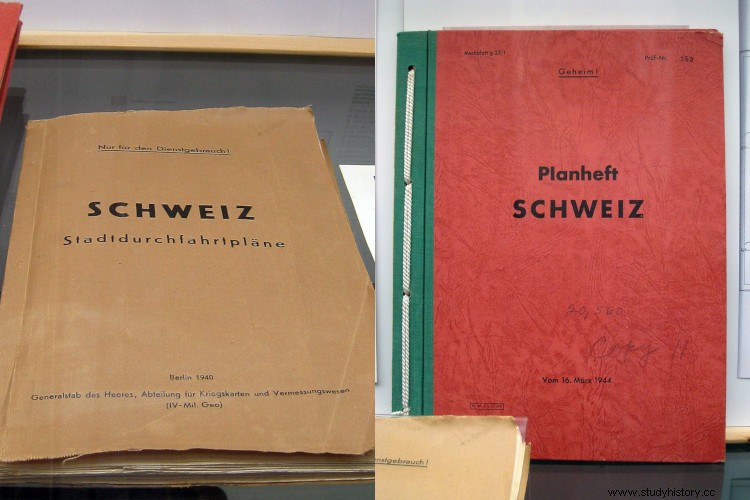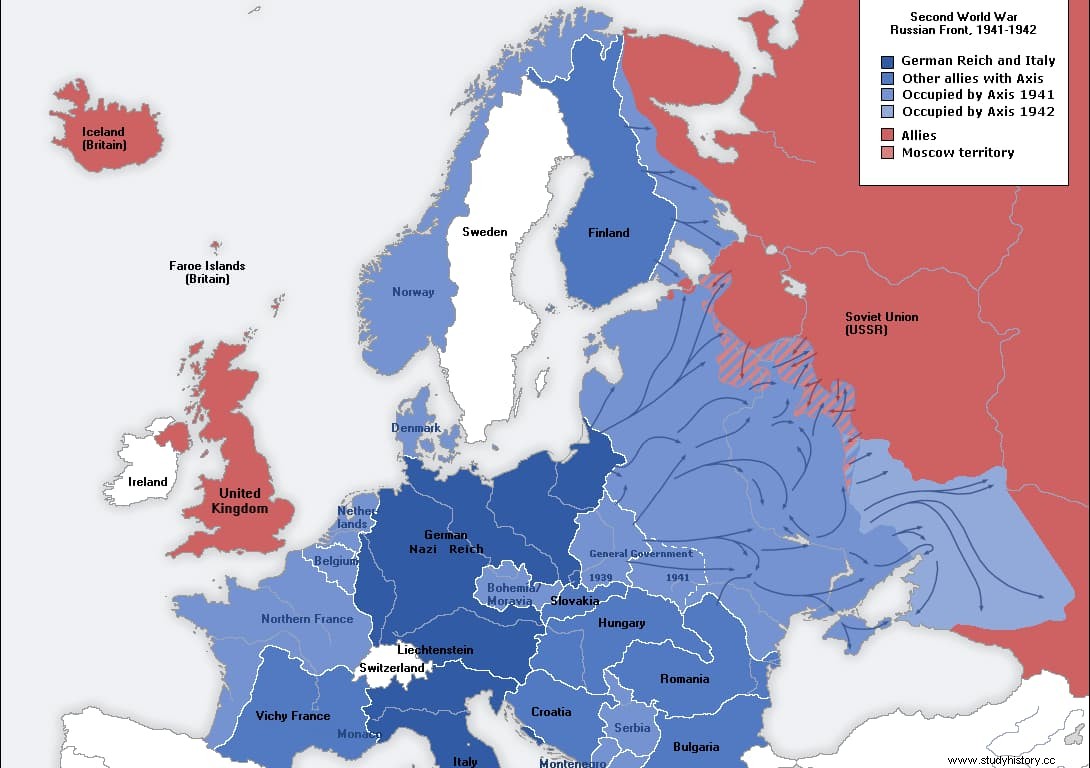We have already explained in another article how was the origin of Swiss neutrality. That proverbial political line of the Swiss country dates back to the perpetual peace treaty signed with France in 1516, which three centuries later expanded making it universal and maintaining it to this day. But it did not spare the Swiss from seeing their land threatened a couple of times. The first was in 1792, materialized in the occupation by the French revolutionary army until 1815; the other, during World War II, when Germany planned an invasion, in what was dubbed Operation Tannenbaum .
Tannenbaum means fir tree and, in fact, the other name by which the plan was known was Operation Grün , that is, green, both allusions to the nature of Switzerland. Design began in late June 1940, just after the Wehrmacht finished Fall Gelb , that is, the invasion of Belgium, the Netherlands, Luxembourg and France. The defeat of the Gallic army and the BEF (British Expeditionary Force ) provoked the Armistice of Compiègne, by which the French territory was divided into two parts:one occupied and the other in the hands of the Vichy Government.

Then Hitler turned his attention to what he considered "the mortal enemies of the new Germany" , the Swiss, whom he described as "the most disgusting and miserable people and political system (...) A degenerate branch of our Volk" . Why? Of course, due to the fact that it was a democracy and also that citizens of different languages coexisted in it, and the population of Teutonic origin seemed to feel more in tune with their French-speaking compatriots than with their German neighbors. But also because of the pan-German aspirations that the Nazi Party outlined in its program, aspiring to unify all the European territories linked to its ethnic group.

In this sense, it was considered that Switzerland had been born taking advantage of a crisis in the Holy Roman Empire, a situation that now had to be cured by incorporating it into the Grossdeutschland (Greater Germany), a nineteenth-century romantic concept that also included the Netherlands, Austria, Belgium, Bohemia-Moravia and part of Poland. Switzerland was included - even in school books - and some ideologues, such as the geopolitical scholar Karl Haushofer, proposed dividing the Swiss territory between Germans, French (from Vichy, obviously) and Italians.
The Swiss saw things very differently, and in 1935, when Hitler officially declared that his government would no longer apply the Treaty of Versailles, they dramatically multiplied their defense budget. Four years later, the German invasion of Poland prompted Switzerland to order a general mobilization, raising the conscription age and raising an army of 100,000 men, despite assurances by the Nazis in 1937 and 1939 that they would respect Swiss neutrality.
On June 25, 1940 -after Paris capitulated, as we said-, while the Swiss forces were preparing to defend the country's borders in what was known as the Limmat Line (which turned the Alps themselves into a natural bastion) and the National Redoubt (a system of fortresses to which to retreat after wearing down the enemy and made up of the Gotthard Pass, an Alpine pass, plus the fortresses of Saint Maurice and Sargans), Hitler recalled the recent conversations between Joachim von Ribbentrop (his foreign minister) with Galeazzo Ciano (his Italian counterpart) to divide up Switzerland and commissioned his commanders to design an invasion plan.

Actually several were made. The first, the work of Captain Otto-Wilhelm Kurt von Menges, was based on the fact that the Swiss would not offer much resistance if an anchluss was carried out. (annexation) as non-violent as possible; it would suffice to repress the small groups that refused. The plan was revised three times, although maintaining its essence, until a fourth draft was presented in October; was the definitive one, baptized with the aforementioned name of Operation Tannenbaum .
Tannenbaum he reduced the twenty-one necessary divisions initially planned to eleven and proposed a diversionary attack on the Jura Massif, in the northern part of the Alps, since the orographic difficulties that these posed for a direct attack would favor the work of the defenders too much. In other words, they had to be weakened first, forcing them to divert forces to another point and then surround them, as in France. Italian participation was essential in this, contributing another fifteen divisions (Mussolini coveted the cantons of Ticino, Valais and Graubünden), so that the total number of men amounted to almost half a million.
And later, once the country was annexed, what were the plans? While the military was working on Operation Tannenbaum , the Ministry of the Interior prepared a report in which, after the war, it was planned to allocate a wide strip of land (from the Somme to Geneva) to German settlers. According to a document titled Aktion S , Heinrich Himmler personally discussed the matter in 1941 with Gottlob Berger, obergruppenführer of the SS, with a view to establishing that organization in Switzerland and appointing a reichkommissar (governor).

Now, as we know, Germany did not actually implement Operation Tannenbaum and in 1944, after the Allied landing in Normandy, it definitively canceled it, although without giving up an anchluss peaceful. The specific reasons for that decision are unknown, although a series of factors are evident that, added together, surely contributed to the fact that the Wehmacht never went beyond a game of cat and mouse, feigning offensives that later did not materialize.
Some of these factors would be due to commercial and/or economic issues. For example, a good part of the industries that supplied Germany (bearings, dairy products, electricity, diverse machinery) had their factories in Swiss territory and that, at least in principle, left them safe from Allied bombing. On the other hand, it was necessary to preserve the Swiss railway network in good condition to guarantee exports of German coal to Italy. And we must not forget that a considerable percentage of German gold reserves were deposited in Swiss banks, and it is possible that, in the face of a hypothetical military defeat, they preferred to keep the country neutral as a refuge.
Other factors are more ethereal. There are those who think that Hitler, despite considering his neighbor as "a grain on the face of Europe" , he had a certain admiration for his culture and his art, which he did not want to see endangered by a war. Likewise, the fact that part of its population was German would make it reluctant to annexation by force of arms, preferring the model used in Austria. Also, being a decentralized state, it would be difficult to pressure the president to drag the entire population.

With all this, strategic and military conditions probably weighed heavily. The fact that Switzerland was completely surrounded by German and Italian territory left it practically at the mercy of these Axis powers, who could wait to fall on it at a convenient time. This implied the fact that it was a minor gain, strategically speaking.
Also, violating those borders would mean engaging in a new campaign that could possibly be more difficult than the previous ones, given the mountainous terrain and especially in winter, something that would prevent the development of a blitzkrieg (Blitzkrieg). Against their modest aviation and artillery, the Swiss infantry was numerous and very well equipped, raising fears that what the Soviets had experienced in Finland might be repeated there; After all, the Wehrmacht only had a dozen Gebirgsjäger (mountain divisions).
In short, Hitler did not give the green light and instead focused on Operation Sea Lion (the invasion of Great Britain), which was the one to which he finally assigned those troops, although that plan was not carried out either. Yes it did, in 1941, the Operation Barbarossa (the invasion of the Soviet Union), a real sink of human and material resources. Meanwhile, Switzerland was able to maintain its neutrality, even seeing its airspace desecrated by all contenders and even suffering aerial bombardment by mistake. A trifle compared to what could have happened.
